Construction and Optimization of an Ecological Network in Zhengzhou Metropolitan Area, China
Abstract
1. Introduction
2. Study Area and Material
2.1. Study Area
2.2. Data and Preprocessing
3. Methodology
3.1. FLUS−Markov Coupling Model
3.2. Morphological Spatial Pattern Analysis
3.2.1. Landscape Connectivity Assessment
3.2.2. Distance Threshold Calculation
3.3. Minimum Cumulative Resistance Model
3.3.1. Least-Cost Path
3.3.2. Gravity Model
3.4. Hydrological Analysis
3.5. Network Structural Evaluation
4. Results
4.1. Identification of Ecological Sources
4.2. Extraction of Ecological Corridors
- (1)
- The level 1 corridors passed through Yuanyang, Wuzhi, Xingyang, Gongyi and Dengfeng (Figure 7), mainly lying along the Yellow River Basin and running through the eastern and western parts of the research area. Five of the level 1 corridors were over 300 km, mainly connecting woodland, grassland, water area and the opening areas of paddy fields as well as all important ecological sources.
- (2)
- Level 2 corridors were mainly distributed close to level 1 corridors, extending outwards on this basis. They connected with other corridors to form the spatial prototype of the ecological network. Corridor 11 was the longest level 2 corridor, at 455.11 km. It was mainly distributed along the periphery of the Yellow River.
- (3)
- Of the level 3 corridors, 21 were less than 100 km, and they supplemented the netlike elements of the ecological network. They mainly formed a mountain corridor network in the Gongyi District, a circular corridor structure in northwest Zhengzhou, and a “pole-axis” corridor pattern in the Kaifeng area. Corridors 40–49 ran through the whole of Gongyi, showing a spatial distribution of three horizontal and three vertical corridors. Corridors 30−37 ran through the Huiji District, Zhongyuan District, Shangjie District and Xingyang City in Zhengzhou and were the only group that passed through a large area of construction land. To the north of Zhongmu, Corridors 41–50 radiated towards Kaifeng City and Weishi County, mainly connecting the paddy fields in the research area.
4.3. Determination of Ecological Nodes
4.4. Construction of Ecological Network
5. Conclusions and Optimization Strategies
5.1. Conclusions
- (1)
- Among the nine major ecological sources, the Yellow River Basin was the only one with a long narrow structure that connected the large-scale ecological sources in the east and west of the network. The remaining sources were concentrated large-area blocks and were distributed in the northeast, southeast and southwest of the research area. These blocks played a role in storing energy, providing habitats for creatures and improving connectivity for ecological flows. The semi-enclosing distribution structure of the nine major sources is important for controlling the future development of the ecological pattern.
- (2)
- Among the 58 ecological corridors, the level 1 corridors overlapped with the Yellow River Basin. With the river’s ecological advantages, these corridors had the largest influence range in the network system. A secondary network with three horizontal and three vertical corridors was formed in the southwestern part of the research area, which had the most complex structure in the network system. The southeastern part was mostly level 3 corridors, which ran toward paddy fields in a pole-axis pattern.
- (3)
- The 10 strategic nodes were scattered across key areas of the ecological network. Most of them were intersections between the source openings and corridors. Within the core areas of the sources, there were 27 natural ecological nodes, which were key nodes in the natural landscape structure. The 33 artificial environment nodes were mainly situated at the intersection between corridors and existing parks, roads and rivers. They were typical representatives of the harmonious development of the artificial environment and natural ecology.
- (4)
- The ecological network contained landscape elements such as paddy fields, woodland, grassland, water area, and bottomland, covering all the ecological types in the research area. Overall, with a high closure degree, connectivity and uniformity index, the network possessed the functional conditions for stable development. The structure of the ecological network complemented the urban space and agricultural space, which is in line with the new concept of coordinated development of ecological and non-ecological space.
5.2. Optimization Strategies
6. Discussion
Author Contributions
Funding
Institutional Review Board Statement
Informed Consent Statement
Data Availability Statement
Acknowledgments
Conflicts of Interest
References
- Chen, L.; Sun, R.; Sun, T.; Yang, L. Eco-security pattern building in urban agglomeration: Conceptual and theoretical thinking. Acta Ecol. Sin. 2021, 41, 4251–4258. [Google Scholar] [CrossRef]
- Fu, B. Thoughts on the recent development of physical geography. Prog. Geogr. 2018, 37, 1–7. [Google Scholar] [CrossRef]
- Liu, S.; Hou, X.; Yin, Y.; Cheng, F.; Zhang, Y.; Dong, S. Research progress on landscape ecological networks. Acta Ecol. Sin. 2017, 37, 3947–3956. [Google Scholar] [CrossRef][Green Version]
- Peng, J.; Zhao, H.; Liu, Y.; Wu, J. Research progress and prospect on regional ecological security pattern construction. Geogr. Res. 2017, 36, 407–419. [Google Scholar] [CrossRef]
- Fang, C.; Zhou, C.; Gu, C.; Chen, L.; Li, S. Theoretical analysis of interactive coupled effects between urbanization and eco–environment in mega–urban agglomerations. Acta Geogr. Sin. 2016, 71, 531–550. [Google Scholar] [CrossRef]
- Lu, D. The Development of economic geography and its function on strategy consultation. Econ. Geogr. 2011, 31, 529–535. [Google Scholar] [CrossRef]
- Naveh, Z. From biodiversity to ecodiversity: A landscape-ecology approach to conservation and restoration. Restor. Ecol. 1994, 2, 180–189. [Google Scholar] [CrossRef]
- Thomas, C.D. Dispersal and extinction in fragmented landscapes. Proc. R. Soc. Biol. Sci. 2000, 267, 139–145. [Google Scholar] [CrossRef]
- Jongman, H.G.R.; Külvik, M.; Kristiansen, I. European ecological networks and greenways. Landsc. Urban Plan. 2004, 68, 305–319. [Google Scholar] [CrossRef]
- Hodson, M.; Marvin, S. ‘Urban ecological security’: A new urban paradigm? Int. J. Urban Reg. Res. 2009, 33, 193–215. [Google Scholar] [CrossRef]
- Steffen, W.; Richardson, K.; Rockström, J.; Cornell, S.E.; Fetzer, I.; Bennett, E.M.; Biggs, R.; Carpenter, S.R.; de Vries, W.; de Wit, C.A.; et al. Planetary boundaries: Guiding human development on a changing planet. Science 2015, 347, 1259855. [Google Scholar] [CrossRef] [PubMed]
- Fu, W.; Yu, K. A million mu of afforestation in Beijing plain area based on ecological security pattern. City Plan. Rev. 2018, 12, 125–131. [Google Scholar]
- Kong, Y.; Li, H.; Li, D.; Qiao, Q.; Xi, X. National scale ecological security pattern. Acta Geogr. Sin. 2009, 29, 5163–5175. [Google Scholar]
- Liu, Y.; Lü, C.; Fu, B.; Yu, B. Terrestrial ecosystem classification and its spatiotemporal changes in China during last 20 years. Acta Ecol. Sin. 2021, 41, 3975–3987. [Google Scholar] [CrossRef]
- Fu, B.; Pan, N. Integrated studies of physical geography in China: Review and prospects. J. Geogr. Sci. 2016, 26, 771–790. [Google Scholar] [CrossRef]
- Wu, L.; He, D.; You, W.; Ji, Z.; Huang, X. A gradient analysis of coastal landscape fragmentation change in Dongshan island, China. Acta Ecol. Sin. 2020, 40, 1055–1064. [Google Scholar] [CrossRef]
- Wu, P.; Zhou, D.; Gong, H. New landscape expansion index: Definition and quantification. Acta Ecol. Sin. 2012, 13, 4270–4277. [Google Scholar] [CrossRef]
- Zhu, W.; Zhang, J.; Cui, Y.; Zhu, L. Ecosystem carbon storage under different scenarios of land use change in Qihe catchment, China. J. Geogr. Sci. 2020, 30, 1507–1522. [Google Scholar] [CrossRef]
- Zhang, H.; Li, X.; Shi, H.; Liu, X. An assessment of the effectiveness of China’s nature reserves for mitigating anthropogenic pressures based on propensity score matching. Acta Geogr. Sin. 2021, 76, 680–693. [Google Scholar] [CrossRef]
- Yan, Y.; Jiao, W.; Wang, K.; Huang, Y.; Chen, J.; Han, Q. Coal-to-gas heating compensation standard and willingness to make clean energy choices in typical rural areas of northern China. Energy Policy 2020, 145, 111698. [Google Scholar] [CrossRef]
- Fang, J.; Yu, G.; Ren, X.; Liu, G.; Zhao, X. Carbon sequestration in China’s terrestrial ecosystems under climate change—Progress on ecosystem carbon sequestration from the CAS strategic priority research program. Bull. Chin. Acad. Sci. 2015, 30, 848–857. [Google Scholar] [CrossRef]
- Zhao, F.; Lan, X.; Li, W.; Zhu, W.; Li, T. Influence of land use change on the surface albedo and climate change in the Qinling-Daba mountains. Sustainability 2021, 13, 10153. [Google Scholar] [CrossRef]
- Fu, Q.; Gu, C. Evaluation of the structural elements of Qingdao ecological network based on the CL-PIOP method. Acta Ecol. Sin. 2017, 37, 1729–1739. [Google Scholar] [CrossRef][Green Version]
- Huang, L.; Chen, Y.; Li, S. Multifractal spectral analysis of land use structure of the Beijing-Tianjin-Hebei urban system. Prog. Geogr. 2019, 38, 50–64. [Google Scholar] [CrossRef]
- Guo, H.; Sun, X.; Lian, L.; Zhang, D.; Xu, Y. Response of water yield function of ecosystem to land use change in Nansi Lake Basin based on CLUE-S model and InVEST model. Chin. J. Appl. Ecol. 2016, 27, 2899–2906. [Google Scholar] [CrossRef]
- Xiao, Z.; Zhang, W.; Hao, L. The evolution of spatial and temporal patterns of Zhengzhou ecological network based on MSPA. Arab. J. Geosci. 2021, 14, 1107. [Google Scholar] [CrossRef]
- He, K.; Lin, T.; Wu, J.; Sui, M.; Liu, L.; Ding, G. Construction of green infrastructure network based on spatial priority in downtown of Fuzhou, China. Chin. J. Appl. Ecol. 2021, 4, 1424–1432. [Google Scholar] [CrossRef]
- Dai, L.; Liu, Y.; Luo, X. Integrating the MCR and DOI models to construct an ecological security network for the urban agglomeration around Poyang Lake, China. Sci. Total Environ. 2021, 754, 141868. [Google Scholar] [CrossRef]
- Shi, Z.; Deng, W.; Zhang, S. Spatial pattern and spatio-temporal change of territory space in Hengduan Mountains region in recent 25 years. Geogr. Res. 2018, 37, 607–621. [Google Scholar] [CrossRef]
- Lan, X.; Li, W.; Tang, J.; Shakoor, A.; Zhao, F.; Fan, J. Spatiotemporal Variation of Climate of Different Flanks and Elevations of the Qinling-Daba Mountains in China during 1969–2018. Sci. Rep. 2022, 12, 6952. [Google Scholar] [CrossRef]
- Lin, Y.; Zhao, J.; Chen, G.; Zhang, M. Optimization of Regional Territory Space Pattern Based on MCR-FLUS-Markov Model. Trans. Chin. Soc. Agric. Mach. 2021, 52, 159–170. [Google Scholar] [CrossRef]
- Huang, L.; Wang, J.; Fang, J.; Zhai, T.; Cheng, H. An integrated approach towards spatial identification of restored and conserved priority areas of ecological network for implementation planning in metropolitan region. Sustain. Cities Soc. 2021, 69, 102865. [Google Scholar] [CrossRef]
- Li, Y.; Wang, Y.; Gao, X.; Hao, T.; Liu, E.; Wang, X. Multi-basin water use network model for evaluating evolution of water resource systems toward sustainable water use—ScienceDirect. J. Clean. Prod. 2021, 281, 124855. [Google Scholar] [CrossRef]
- Li, Q.; Zhang, Z.; Wan, L.; Yang, C.; Zhang, J.; Ye, C.; Chen, Y. Landscape pattern optimization in Ningjiang River Basin based on landscape ecological risk assessment. Acta Geogr. Sin. 2019, 74, 1420–1437. [Google Scholar] [CrossRef]
- Petsas, P.; Almpanidou, V.; Mazaris, A.D. Landscape connectivity analysis: New metrics that account for patch quality, neighbors’ attributes and robust connections. Landsc. Ecol. 2021, 36, 3153–3168. [Google Scholar] [CrossRef]
- Liu, Y.; Yang, S.; Ni, W.; He, J. Comprehensive assessment method on ecological patch importance: A case study in Sichuan Province, China. Acta Ecol. Sin. 2020, 40, 3602–3611. [Google Scholar] [CrossRef]
- Huo, J.; Shi, Z.; Zhu, W.; Xue, H.; Chen, X. A multi–scenario simulation and optimization of land use with a Markov–FLUS coupling model: A case study in Xiong’an New Area, China. Sustainability 2022, 14, 2425. [Google Scholar] [CrossRef]
- Wang, L.; Chen, s.; Zhu, W.; Ren, H.; Zhang, L.; Zhu, L. Spatiotemporal variations of extreme precipitation and its potential driving factors in China’s North-South Transition Zone during 1960–2017. Atmos. Res. 2021, 252, 105429. [Google Scholar] [CrossRef]
- Liang, Y.; Zhao, Y. Construction and optimization of ecological network in Xi’an based on landscape analysis. Chin. J. Appl. Ecol. 2020, 31, 3767–3776. [Google Scholar] [CrossRef]
- Hou, Q.; Du, Y.; Wong, W.; Zeng, Z.; Zhang, L.; Duan, Y.; Hou, X. Smart city oriented ecological corridor layout of Sanshui River Basin in arid area of Loess Plateau. Sustain. Energy Technol. Assess. 2021, 44, 100993. [Google Scholar] [CrossRef]
- Han, J.; Yu, M. A multi-factor integration identification method of ecological security pattern and optimization suggestions: A case of Changshan county, Quzhou city. Geogr. Res. 2021, 40, 1078–1095. [Google Scholar] [CrossRef]
- Lurgi, M.; Galiana, N.; Broitman, B.R.; Kéfi, S.; Wieters, E.A.; Navarrete, S.A. Geographical variation of multiplex ecological networks in marine intertidal communities. Ecology 2020, 101, 03165. [Google Scholar] [CrossRef] [PubMed]
- Yin, B.; He, S.; Li, Y.; Li, Y. Development and application of an ecological network model for a coastal megalopolis based on land–sea integration. Acta Ecol. Sin. 2018, 38, 4373–4382. [Google Scholar] [CrossRef]
- Qi, K.; Fan, Z. Evaluation method for landscape connectivity based on graph theory: A case study of natural forests in Minqing County, Fujian Province. Acta Ecol. Sin. 2016, 36, 7580–7593. [Google Scholar] [CrossRef][Green Version]
- Wolstenholme, P.; Pedley, S.M. Permeability of commercial landscapes: Integrating plantation forest trackways into ecological networks. Landsc. Ecol. 2021, 36, 1459–1474. [Google Scholar] [CrossRef]
- Li, Z.; Xia, J.; Deng, X.; Yan, H. Multilevel modelling of impacts of human and natural factors on ecosystem services change in an oasis, Northwest China. Resour. Conserv. Recycl. 2021, 169, 105474. [Google Scholar] [CrossRef]
- Ma, S.; Xie, D.; Zhang, X.; Peng, Z.; Hong, H.; Luo, Z.; Xiao, J. Measures of land ecological security early warning and its spatial-temporal evolution in the ecologically sensitive area of the Three Gorges reservoir area: A case study of Wanzhou District, Chongqing City. Acta Ecol. Sin. 2017, 37, 8227–8240. [Google Scholar] [CrossRef][Green Version]
- Arif, M.; Tahir, M.; Zhang, J.; Li, C. Impacts of riparian width and stream channel width on ecological networks in main waterways and tributaries. Sci. Total Environ. 2021, 792, 148457. [Google Scholar] [CrossRef]
- Zhang, Y.; Xu, D.; Li, X.; Zhang, X.; Wang, X.; Wang, S. Construction of ecological corridors and identification of key nodes in the core area of China–Laos transportation corridors. Acta Ecol. Sin. 2020, 40, 1933–1943. [Google Scholar] [CrossRef]
- Dong, J.; Peng, J.; Xu, Z.; Liu, Y.; Wang, X.; Li, B. Integrating regional and interregional approaches to identify ecological security patterns. Landsc. Ecol. 2021, 36, 2151–2164. [Google Scholar] [CrossRef]
- Wu, J.; Luo, K.; Ma, H.; Wang, Z. Ecological security and restoration pattern of Pearl River Delta, based on ecosystem service and gravity model. Acta Ecol. Sin. 2020, 40, 8417–8429. [Google Scholar]
- He, D.J. Landscape Ecology, 2nd ed.; China Forestry Publishing House: Beijing, China, 2019; pp. 255–284. ISBN 9787521903348. [Google Scholar]
- Dai, F.; Bi, S.; Guo, X.; Chen, M. Evolution of spatial pattern of London green apace aystem based on morphological spatial pattern analysis and its relevance to policy. Urban Plan. Int. 2021, 36, 50–58. [Google Scholar] [CrossRef]
- Chu, M.; Lu, J.; Sun, D. Influence of urban agglomeration expansion on fragmentation of green space: A case study of Beijing-Tianjin-Hebei urban agglomeration. Land 2022, 11, 275. [Google Scholar] [CrossRef]
- Shen, Z.; Wu, W.; Chen, M.; Tian, S.; Wang, J. Linking greenspace ecological networks optimization into urban expansion planning: Insights from China’s total built land control policy. Land 2021, 10, 1046. [Google Scholar] [CrossRef]




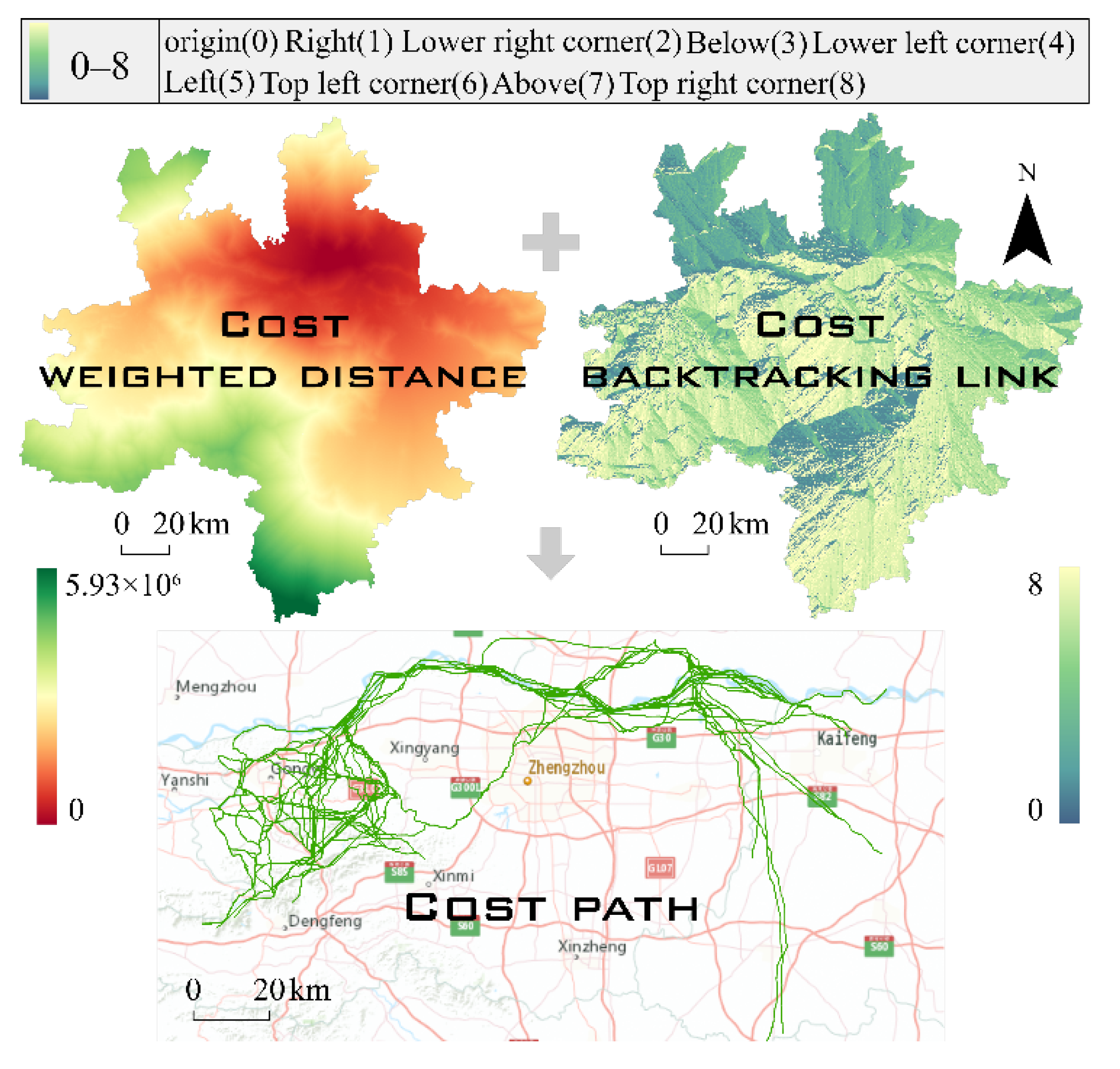
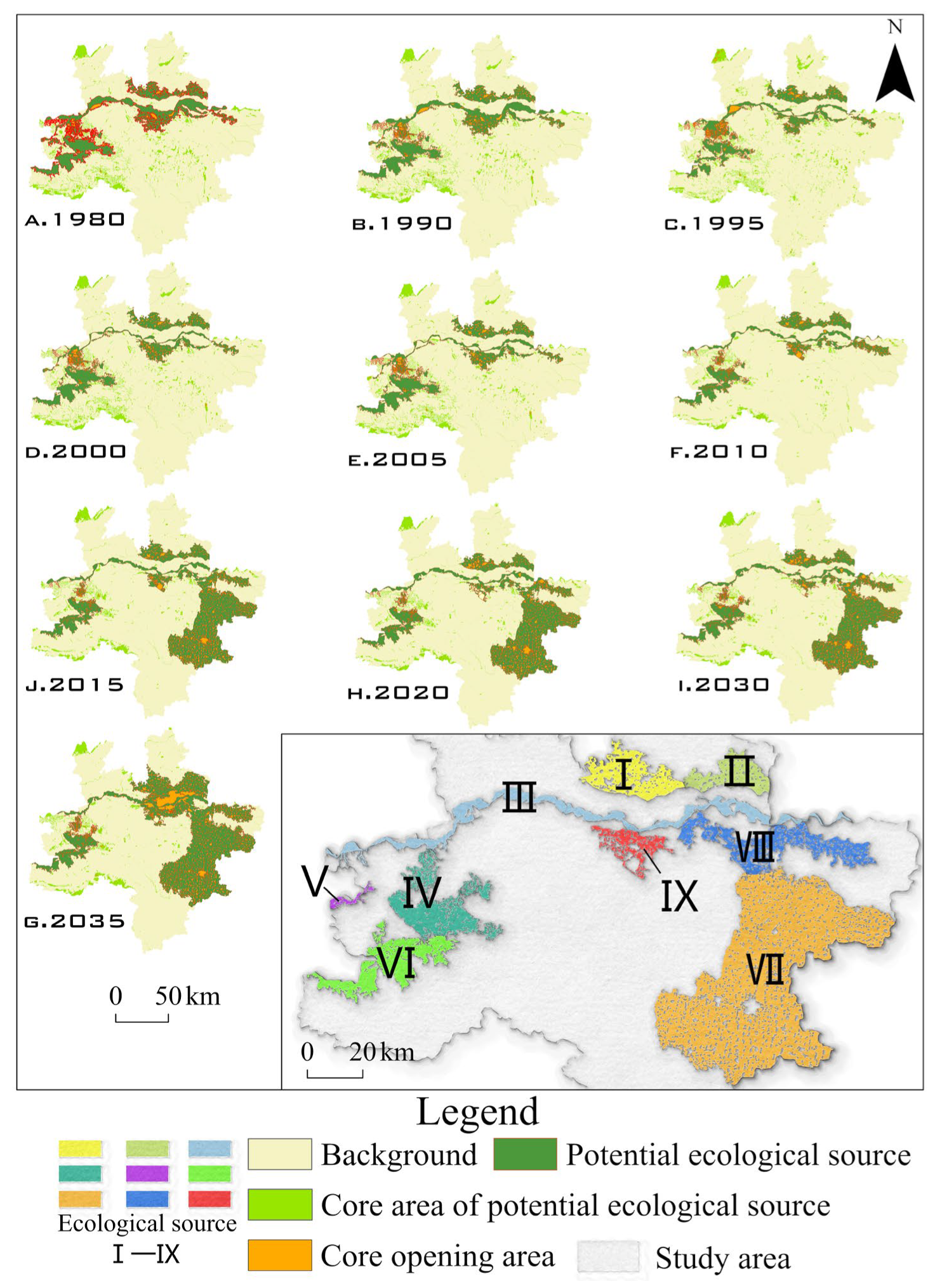
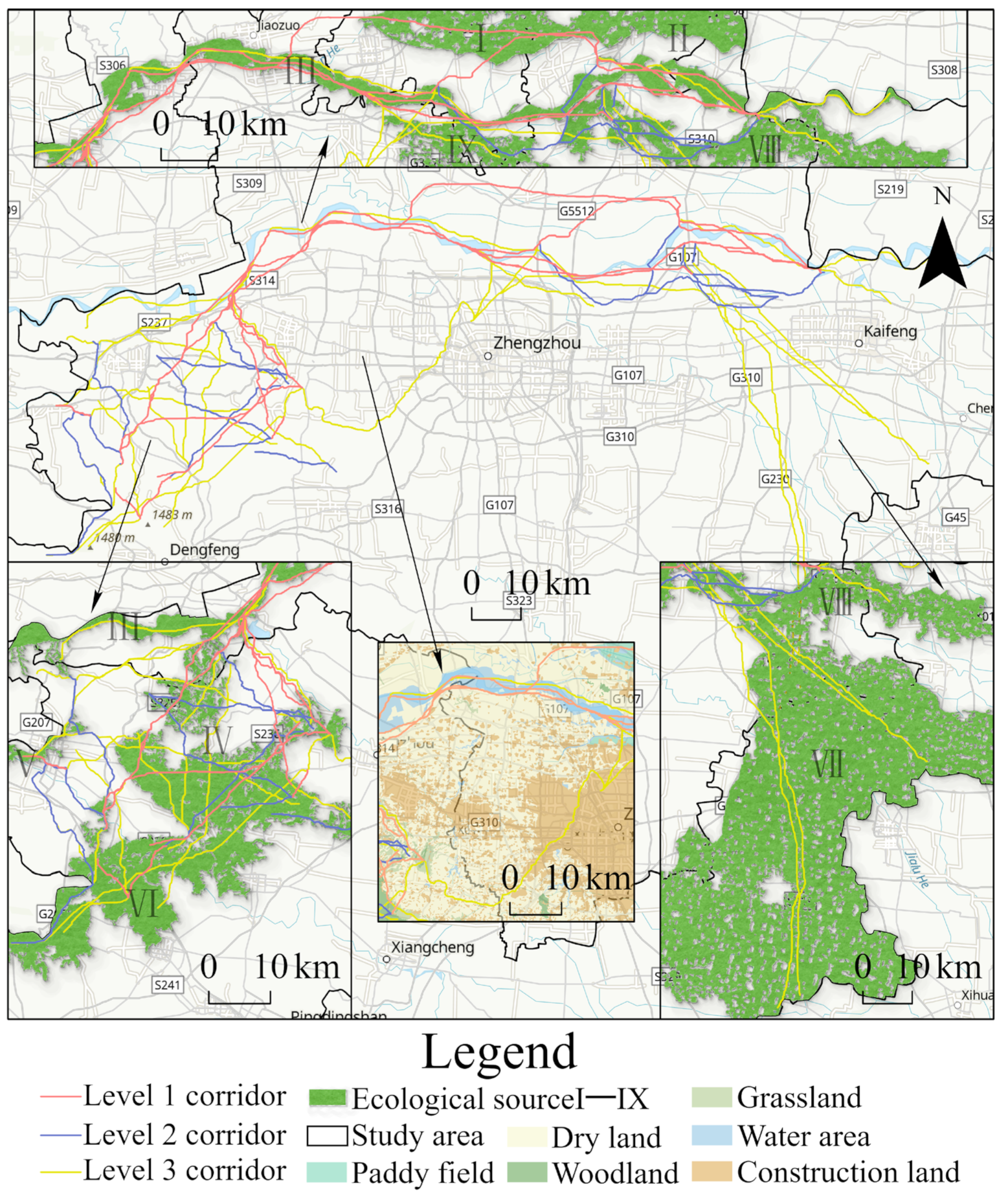
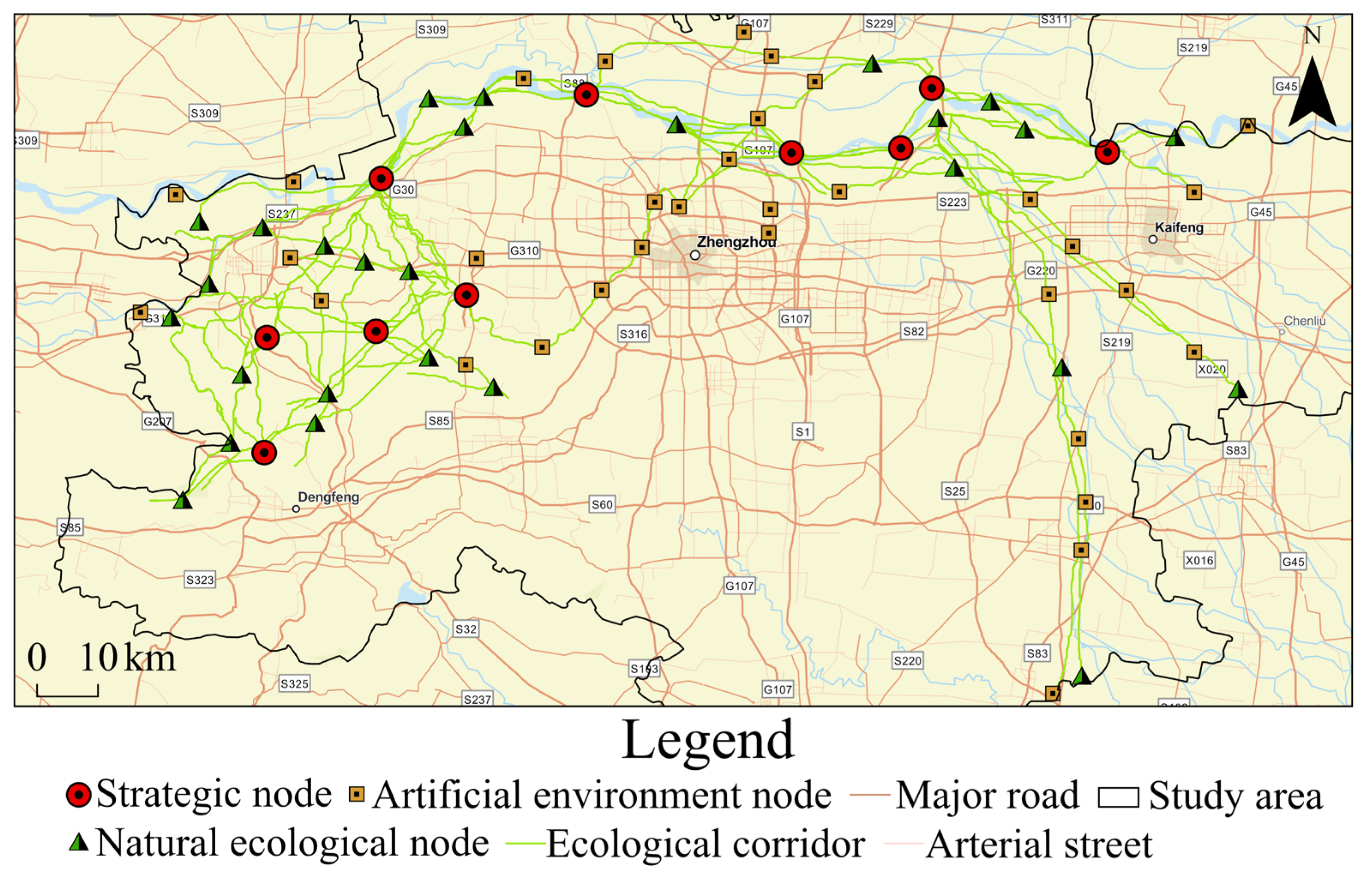
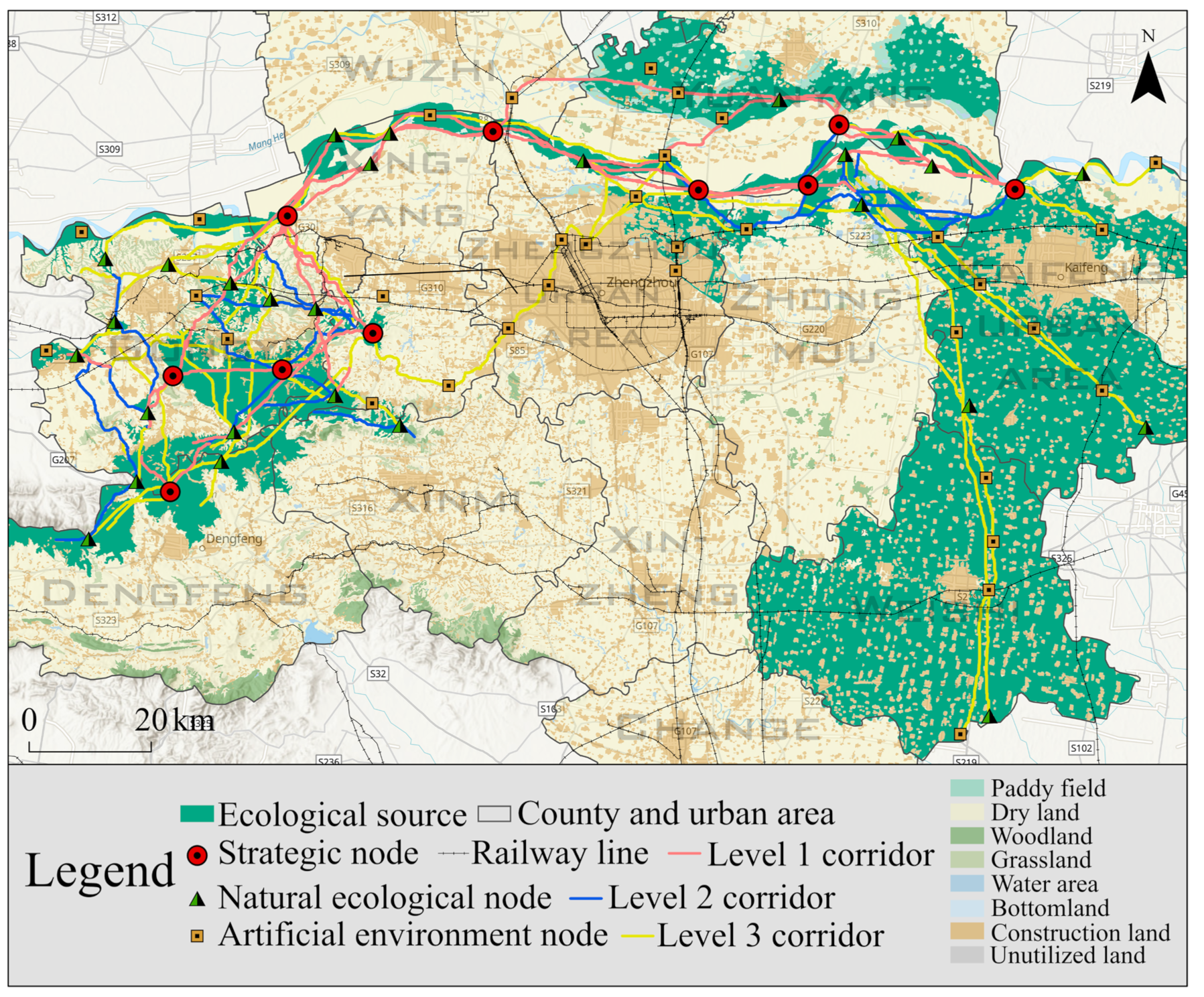
| Basic Module of Model | Parameter Configuration | Description and Requirements | Specific Content Setting |
|---|---|---|---|
| Back propagation−artificial neural network | Land Use | The reclassified land raster data was reset according to the land class numbers. The part outside the research area was set to “No Data Value”, and the inside part was set to “Valid Data”. | The three groups of data substituted into the research come from 2010, 2015 and 2020, respectively. |
| ANN Training | Land use data, including input, hidden, and output layers, etc. were trained and evaluated. | Uniform Sampling was selected as the sampling model. Sampling Rata was set to 1% of the pixels in the research area selected for sampling. Hidden Layer was set to 12 to ensure the high accuracy of the results, thereby reducing errors. [31] | |
| Save Path | The output files can be set according to two kinds of research requirements of single accuracy or double accuracy. | Accuracy type was set to Double Accuracy. | |
| Driving Data | Driving factors’ raster data were introduced to simulate the impact of multiple requirements on land development. | A total of 6 types of driving factors were set, all of which are processed into 5906 × 6133 raster data. | |
| Cellular automata space configuration | Probability Data | Probability files of land suitability development were introduced. | The land class probability results were obtained by the artificial neural network module. |
| Restricted Data | The restricted area was set to binary data. The value of 0 was not allowed to be converted, and the value of 1 was allowed. | Rivers and ecological reserves in the research area were the main restricted areas. | |
| Simulation Setting | The simulation parameters were set in detail. Maximum Number of Iterations was 300 times. Neighborhood (odd) was 3 × 3. Accelerate was 0.1. Thread was 8. The Land Use Demand was calculated by the Markov chain. The Cost Matrix was set as a land transfer matrix in the state of natural evolution. Weight of Neighborhood was adjusted according to the simulation results during the simulation [37]. | ||
| Markov chain | Predict Year | Divided into the initial year, end year and prediction year | The land data of 2010 and 2015 were used to calculate the land demand in 2030, and the land data of 2015 and 2020 were used to calculate the land demand in 2035. |
| Accuracy test of results | Accuracy of Kappa | Mathematical analysis was carried out on the accuracy of images of land use spatial layout classification. | The Kappa accuracy of the two periods was 0.702565 and 0.899496, respectively, which was relatively high. |
| Accuracy of OA | Overall accuracy was the ratio of the model’s correct prediction number to the total number of all test sets. | The OA accuracy of the two periods was 0.826521 and 0.936027, respectively, which was relatively high. | |
| MSPA Elements | Ecological Meaning |
|---|---|
| Core | The larger green blocks in the foreground land are mostly an important part of the “ecological sources” in the ecological network, and they are often used as habitats or migration sites for species of creatures. |
| Islet | Small green blocks with weak connectivity or relatively isolated ones are equivalent to “ecological islands” in the ecological network. |
| Bridge | The natural ecological corridors connecting different core areas have the function of exchanging energy and materials between adjacent core areas. |
| Branch | The corridors of the MSPA element type connecting the core and non-core areas can exchange materials and energy between the core areas and surrounding landscapes. |
| Edge | The transition area between the core area and other types of peripheral land can reduce the impact of external factors, protect the ecological function and sustainability of the core area, and take a strong fringe effect. |
| Loop | The interconnected passages within the same core area are for materials and energy exchange within the core area. |
| Perforation | Similar to the edge area, the transition area between the core area and the internal non-vegetation type of land has a fringe effect. |
| Distance Threshold | 100 m | 500 m | 1000 m | 1500 m | 2000 m |
|---|---|---|---|---|---|
| Index | dLCP | ||||
| 1990 | 0.61 | 0.75 | 0.72 | 0.72 | 1.03 |
| 2005 | 0.57 | 0.96 | 0.96 | 0.92 | 1.26 |
| 2020 | 0.84 | 0.95 | 1.42 | 1.54 | 1.31 |
| Index | dIIC | ||||
| 1990 | 0.55 | 0.63 | 0.63 | 0.63 | 0.69 |
| 2005 | 0.55 | 0.78 | 0.78 | 0.77 | 0.85 |
| 2020 | 0.83 | 0.89 | 1.09 | 1.18 | 1.14 |
| Index | dPC | ||||
| 1990 | 0.56 | 0.70 | 0.70 | 0.71 | 0.76 |
| 2005 | 0.55 | 0.87 | 0.92 | 0.91 | 0.98 |
| 2020 | 0.83 | 0.92 | 1.19 | 1.33 | 1.33 |
| Resistance Layer | Factor Classification/ Grading | Resistance Value | Resistance Weight | Resistance Layer | Factor Classification/ Grading | Resistance Value | Resistance Weight |
|---|---|---|---|---|---|---|---|
| MSPA landscape factors | Core | 10 | 0.5638 | Land cover types | Paddy field | 40 | 0.2634 |
| Islet | 10 | Dry land | 50 | ||||
| Edge | 20 | Woodland | 10 | ||||
| Bridge | 20 | Grassland | 20 | ||||
| Branch | 30 | Water area | 30 | ||||
| Loop | 30 | Bottomland | 30 | ||||
| Perforation | 40 | Construction land | 100 | ||||
| Background | 80 | Unutilized land | 60 | ||||
| Elevation (h)/m | h < 150 m | 10 | 0.1178 | Slope (i)/° | i < 5° | 10 | 0.055 |
| 150 m ≤ h < 300 m | 20 | 5° ≤ i < 10° | 20 | ||||
| 300 m ≤ h < 600 m | 40 | 10° ≤ i < 30° | 40 | ||||
| 600 m ≤ h < 1000 m | 70 | 30° ≤ i < 45° | 60 | ||||
| 1000 m ≤ h | 90 | 45° ≤ i | 80 |
| 1980 to 2035 (km2) | Paddy Field | Dry Land | Woodland | Grassland | Water Area | Bottomland | Construction Land | Unutilized Land | Total |
|---|---|---|---|---|---|---|---|---|---|
| Paddy field | — | 238.08 | 4.21 | 3.18 | 102.43 | 2.02 | 421.29 | — | 771.21 |
| Dry land | 2442.75 | — | 174.15 | 214.17 | 236.06 | 12.95 | 4406.21 | — | 7486.29 |
| Woodland | 58.03 | 405.23 | — | 73.56 | 11.92 | 0.13 | 202.29 | — | 751.16 |
| Grassland | — | 381.09 | 141.9 | — | 14.54 | 3.55 | 183.59 | — | 724.67 |
| Water area | 53.02 | 438.17 | 4.79 | 1.1 | — | 107.09 | 97.2 | 1.06 | 702.43 |
| Bottomland | — | 3.22 | — | — | 0.39 | — | 1.72 | — | 5.33 |
| Construction land | 433.34 | 1076.13 | 16.48 | 13.64 | 40.38 | 0.34 | — | — | 1580.31 |
| Unutilized land | 4.5 | 4.26 | 2.49 | 0.05 | 0.44 | 0.23 | 0.9 | — | 12.87 |
| Total | 2991.64 | 2546.18 | 344.02 | 305.7 | 406.16 | 126.31 | 5313.2 | 1.06 | 12,034.27 |
| Patch Number | 1 | 2 | 3 | 4 | 5 | 6 | 7 | 8 | 9 | 10 | 11 |
|---|---|---|---|---|---|---|---|---|---|---|---|
| 1 | — | 5.99 | 3.75 | 3.06 | 4.74 | 2.24 | 2.70 | 2.45 | 4.15 | 1.90 | 1.61 |
| 2 | — | — | 101.81 | 1.44 | 2.00 | 1.10 | 1.31 | 1.20 | 1.88 | 0.99 | 0.87 |
| 3 | — | — | — | 1.11 | 1.50 | 0.86 | 1.01 | 0.93 | 1.44 | 0.78 | 0.70 |
| 4 | — | — | — | — | 1.67 | 0.95 | 1.13 | 1.04 | 1.60 | 0.87 | 0.78 |
| 5 | — | — | — | — | — | 18.59 | 61.18 | 35.44 | 265.43 | 15.55 | 9.44 |
| 6 | — | — | — | — | — | — | 11.52 | 147.38 | 25.24 | 109.43 | 49.75 |
| 7 | — | — | — | — | — | — | — | 22.85 | 253.24 | 11.08 | 6.99 |
| 8 | — | — | — | — | — | — | — | — | 64.39 | 113.97 | 33.46 |
| 9 | — | — | — | — | — | — | — | — | — | 23.50 | 13.17 |
| 10 | — | — | — | — | — | — | — | — | — | — | 116.81 |
| 11 | — | — | — | — | — | — | — | — | — | — | — |
| Corridor Level | Patch Number | Corridor Length (km) | Corridor Level | Patch Number | Corridor Length (km) |
|---|---|---|---|---|---|
| Level—1 corridors | 1 | 455.16 | Level—3 corridors | 30 | 43.47 |
| 2 | 436.14 | 31 | 57.28 | ||
| 3 | 471.36 | 32 | 89.31 | ||
| 4 | 18.12 | 33 | 96.03 | ||
| 5 | 516.24 | 34 | 41.49 | ||
| 6 | 22.38 | 35 | 67.94 | ||
| 7 | 88.92 | 36 | 65.82 | ||
| 8 | 29.22 | 37 | 154.74 | ||
| 9 | 13.86 | 38 | 99.24 | ||
| 10 | 333.30 | 39 | 172.74 | ||
| Level—2 corridors | 11 | 455.11 | 40 | 38.46 | |
| 12 | 42.60 | 41 | 81.90 | ||
| 13 | 78.30 | 42 | 107.94 | ||
| 14 | 81.48 | 43 | 96.54 | ||
| 15 | 61.98 | 44 | 90.84 | ||
| 16 | 26.64 | 45 | 48.90 | ||
| 17 | 38.22 | 46 | 44.28 | ||
| 18 | 51.06 | 47 | 75.96 | ||
| 19 | 119.64 | 48 | 31.68 | ||
| 20 | 17.10 | 49 | 61.56 | ||
| 21 | 43.92 | 50 | 32.46 | ||
| 22 | 113.34 | 51 | 73.86 | ||
| 23 | 38.04 | 52 | 151.98 | ||
| 24 | 51.24 | 53 | 184.50 | ||
| 25 | 23.46 | 54 | 107.76 | ||
| 26 | 84.30 | 55 | 178.98 | ||
| 27 | 10.66 | 56 | 529.02 | ||
| 28 | 10.08 | 57 | 88.56 | ||
| 29 | 55.62 | 58 | 246.24 |
| Number of Corridors | Number of Nodes | α Index | β Index | γ Index | Cost Ratio | |
|---|---|---|---|---|---|---|
| Level—1 corridors and Strategic nodes | 10 | 10 | 0.07 | 1.00 | 0.42 | 1.00 |
| Level—2, 3 corridors and natural ecological nodes | 48 | 27 | 0.45 | 1.78 | 0.64 | 0.99 |
| Level—2, 3 corridors and artificial environmental nodes | 48 | 33 | 0.26 | 1.45 | 0.52 | 0.99 |
Publisher’s Note: MDPI stays neutral with regard to jurisdictional claims in published maps and institutional affiliations. |
© 2022 by the authors. Licensee MDPI, Basel, Switzerland. This article is an open access article distributed under the terms and conditions of the Creative Commons Attribution (CC BY) license (https://creativecommons.org/licenses/by/4.0/).
Share and Cite
Huo, J.; Shi, Z.; Zhu, W.; Li, T.; Xue, H.; Chen, X.; Yan, Y.; Ma, R. Construction and Optimization of an Ecological Network in Zhengzhou Metropolitan Area, China. Int. J. Environ. Res. Public Health 2022, 19, 8066. https://doi.org/10.3390/ijerph19138066
Huo J, Shi Z, Zhu W, Li T, Xue H, Chen X, Yan Y, Ma R. Construction and Optimization of an Ecological Network in Zhengzhou Metropolitan Area, China. International Journal of Environmental Research and Public Health. 2022; 19(13):8066. https://doi.org/10.3390/ijerph19138066
Chicago/Turabian StyleHuo, Jingeng, Zhenqin Shi, Wenbo Zhu, Tianqi Li, Hua Xue, Xin Chen, Yanhui Yan, and Ran Ma. 2022. "Construction and Optimization of an Ecological Network in Zhengzhou Metropolitan Area, China" International Journal of Environmental Research and Public Health 19, no. 13: 8066. https://doi.org/10.3390/ijerph19138066
APA StyleHuo, J., Shi, Z., Zhu, W., Li, T., Xue, H., Chen, X., Yan, Y., & Ma, R. (2022). Construction and Optimization of an Ecological Network in Zhengzhou Metropolitan Area, China. International Journal of Environmental Research and Public Health, 19(13), 8066. https://doi.org/10.3390/ijerph19138066







